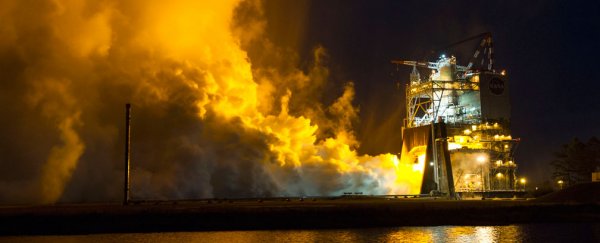With NASA's trip to Mars getting ever closer, the space agency is completing tests of the rocket parts that will soon send astronauts further than humankind has ever travelled before.
In preparation for the mission to the red planet, last week NASA successfully conducted the penultimate 'hot fire' test of its legendary RS–25 engine. The engine, sometimes nicknamed "the Ferrari of rocket engines" in reference to its awesome power and efficiency, was fired up for a 535-second test: the length of time it would take the RS–25 to propel the Space Launch System (SLS) rocket into space.
In this amount of time, the RS–25 generates about 232,000 kilograms (512,000 pounds) of thrust. According to Martin Burkey at NASA's Rocketology blog, that's equivalent to 12 million horsepower, with enough thrust to push 10 giant aircraft carriers around the ocean at almost 40 km/h (25 mph).
Last week's test, the sixth in an ongoing series of engine evaluations, was conducted at the Stennis Space Centre in southern Mississippi in the US and should help NASA engineers collect valuable engine performance data.
The RS–25 is not a new engine; it was developed as long ago as the 1970s and has previously seen time in space as part of the discontinued Space Shuttle program. But its repurposing in the all-new SLS program means the space agency has a lot to get right with the old performer.
Foremost is ensuring that the engine's new controller components work correctly, but the upgraded RS–25 also has to demonstrate to NASA's satisfaction that it can withstand temperature and pressure testing on the ground before uncrewed flights can kick off.
The temperature gamut the RS–25 has to withstand is pretty insane. Burkey says it needs to handle temperatures as low as minus 250 degrees Celsius (minus 400 degrees Fahrenheit) when? the propellants enter the engine, and as high as 3,300 degrees Celsius (6,000 degrees Fahrenheit) as the exhaust exits the combustion chamber where the propellants are burned.
When ground testing is completed, uncrewed flights are scheduled to start as soon as 2018, with the RS–25 taking the SLS and the attached Orion spacecraft around the Moon. Provided this maiden flight goes as scheduled, crewed missions are set to follow shortly after, with the ultimate goal of sending astronauts to Mars some time in the 2030s.
